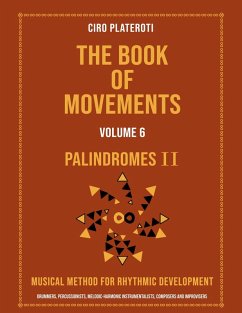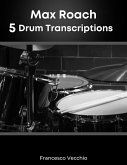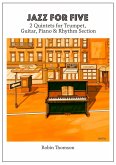Palindromes II Palindromes are movement patterns with certain special characteristics.Its internal components keep symmetrical distances. They read the same from front to back and from back to front- These mirrored patterns are special in that when you practice them They allow us to play fluidly with both hands, the same pattern.Any pattern that is leading with the right hand is automatically played leading with the right hand.left, achieving a great kinesthetic balance. The palindromes sound very exotic and musical at the same time, there are all the movement patterns palindromics that exist in metric 3/8; 4/8; 5/8; 6/8; 7/8; 8/8; 9/8; 8/10; 11/8; 12/8; 8/13; 8/14; 8/15 and 8/16 Irregular metrics with these patterns sound amazing This second volume has the same palindromes (thousands) but with a different fingering treatment which gives a totally different in fluency and language of movement. Beyond the musical particularities that the rhythmic palindromes carry in themselves,it is also worth noting the defined character of the different kinds of movements that in this second book are raised. In Palindromes 2 the focus of movement is radically changed in relation to the first book. Such an approach presented here is called ARTICULATIONS. Perhaps we have never heard of these movements called Articulations and probably, they are named like this for the first time, but this type of movement can be observe in those who play drums of various musical manifestations influenced by Africa mainly, we can put as an example Djembe, Conga, Peruvian Cajon, Tambor Alegre, Clarín, Cumaco, etc. The musical phrases that are formed from this kind of bodily motor skills that are so dynamic and intuitive, they are very clear, rhythmic and melodic, they are useful both for forming bases and for solos, since they contain a strong presence of silences. This marks a big difference with the movements played on the war drum (so widespread and influential, with its rudiments) where filler notes abound between the main beats that form the rhythmic motive. This spatiality between stroke and stroke leads us to bring into play another bodily balance and induces to feel the music from a more kinesthetic than intellectual place. To this end, the graphic representations of the palindromic motives shown here are arranged in sequences of two colors that make it clear where in space time occupies every blow and every silence. This method has specifically selected palindromic movement patterns and classified, is a compilation of which there are no antecedents in musical history. It is aimed at musicians who play drums, percussion of all kinds, as well as piano, bass, guitar, Hang, etc. It is also ideal for instrumentalists, composers or improvisers looking to create with shapes. musical rhythms to address from your instrument, whether or not you know how to read traditional musical notation. The rhythmic motifs presented here are grouped into 14 different meters, regular and irregular lines that are useful for both rhythmic, melodic, or harmonic lines. IMPORTANT NOTICE: After practicing this 6th volume of The Book of Movements,You will notice changes in your self-perception since both hemispheres of the brain are exercised.
Dieser Download kann aus rechtlichen Gründen nur mit Rechnungsadresse in A, B, CY, CZ, D, DK, EW, E, FIN, F, GR, H, IRL, I, LT, L, LR, M, NL, PL, P, R, S, SLO, SK ausgeliefert werden.









